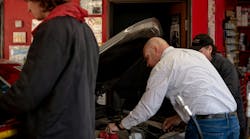March 17, 2021—Telematics have had quite the evolution. From a relative unknown technological advancement 20 years ago, telematics have become a known and necessary tool for fleet management today. Whether its tracking the location of each vehicle, monitoring speed and brake patterns, or analyzing trends in fuel consumption and fluid levels, telematics has allowed fleet managers to maximize efficiency.
While this data is most often accessed and acted upon by those fleet companies, quick lubes should pay close attention to telematics.
NOLN reported in December of 2020 that the expected number of commercial vehicles that will utilize some kind of telematics service will rise to 63.5 million, nearly triple the amount from 2015. That means more vehicles will be carefully maintained and primed for efficiency.
For quick lubes that presents a prime opportunity to provide more preventative and less reactive maintenance and to do it quickly, a unique and valuable skill of the quick lube industry that is attractive to fleet companies who want to maximize efficiency and minimize costs, said Kurt Wyman, vice president of sales and general manager of Teletrac Navman, a global telematics software-as-a-service provider.
Fleet Service Opportunities
Wyman recommends that if a quick lube is already working with a fleet manager, they should be requesting weekly telematics updates regarding the fleet. Quick lubes should be an active participant in making sure the demands of the fleet are met.
The days of quick lubes scheduling out service of fleets months in advance on an arbitrary schedule are gone. With a telematics system, fleets will know exactly when they need service.
Using the telematics data is also a helpful tool for quick lubes because they can forecast what maintenance will be needed and ensure that they have the right tools, equipment and products to work on the vehicles.
And while the commercial reliance on telematics will continue to grow, there is also momentum towards using it on individual consumer vehicles, Wyman said. OEMs are already using telematics data to find potential repair and maintenance issues. But through that system they are pushing the consumer to get it fixed at a dealership. Wyman said his company is in conversation with various OEMs and people who work with OEMs to monitor telematic data. That will increasingly become a part of Teletrac Navman's business model.
But with Massachusetts’ right to repair legislation approved last November, and a growing call for right to repair legislation around the country, individual telematic data will increasingly be available to independent shops and consumers.
According to the 2020 NOLN Operator Survey, around 20 percent of their operators' business comes from fleet management. So while telematics has been on the minds of some operators, mostly multi-shop operators or shops in a larger chain, the introduction of telematics for the individual consumer should be on the minds of all quick lubes.
For quick lubes to thrive in the next iteration of the industry, embracing telematics will be important, Wyman said. Fleet companies and quick lubes must be ready to adapt to it or they’ll be left in the dust.





